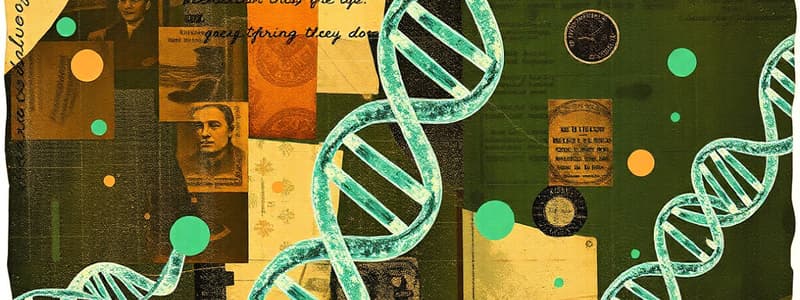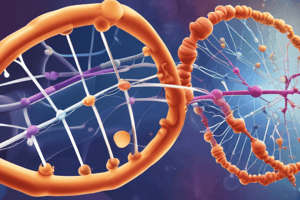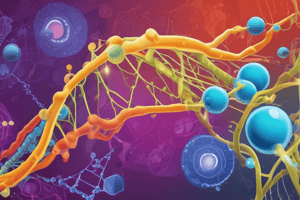Podcast
Questions and Answers
Which chemical linkage is responsible for creating the backbone of a single strand of DNA?
Which chemical linkage is responsible for creating the backbone of a single strand of DNA?
- Hydrophobic interaction
- Peptide bond
- Hydrogen bond
- Phosphodiester bond (correct)
What does the term 'directionality' refer to in the context of a DNA strand?
What does the term 'directionality' refer to in the context of a DNA strand?
- The complementary base pairing rules (A with T, G with C).
- The specific sequence of nucleotides.
- The orientation of the strand, defined by the 5' and 3' ends. (correct)
- The ability of DNA to form a double helix.
Which of these enzymes is NOT directly involved in bacterial DNA replication?
Which of these enzymes is NOT directly involved in bacterial DNA replication?
- Primase
- DNA Polymerase I
- RNA Polymerase (correct)
- DNA Polymerase III
During DNA replication in bacteria, what is the PRIMARY function of DNA ligase?
During DNA replication in bacteria, what is the PRIMARY function of DNA ligase?
Why is the high fidelity of replicative DNA polymerases essential for cell survival?
Why is the high fidelity of replicative DNA polymerases essential for cell survival?
What is the primary reason telomeres are composed of repetitive sequences?
What is the primary reason telomeres are composed of repetitive sequences?
How does negative supercoiling contribute to bacterial DNA compaction and function?
How does negative supercoiling contribute to bacterial DNA compaction and function?
What is the role of topoisomerases in managing DNA topology?
What is the role of topoisomerases in managing DNA topology?
Which of the following BEST describes the arrangement of DNA within a nucleosome?
Which of the following BEST describes the arrangement of DNA within a nucleosome?
What information does capillary electrophoresis data provide in STR profiling?
What information does capillary electrophoresis data provide in STR profiling?
In the context of STR profiling and population genetics, what does the Hardy-Weinberg Equilibrium (HWE) principle allow us to predict?
In the context of STR profiling and population genetics, what does the Hardy-Weinberg Equilibrium (HWE) principle allow us to predict?
During PCR for STR analysis, what is the function of the primers used?
During PCR for STR analysis, what is the function of the primers used?
Which strand of DNA is used by RNA polymerase as a template during bacterial transcription?
Which strand of DNA is used by RNA polymerase as a template during bacterial transcription?
During bacterial transcription, what is the role of the sigma factor?
During bacterial transcription, what is the role of the sigma factor?
How does the 'open complex' contribute to the initiation of bacterial transcription?
How does the 'open complex' contribute to the initiation of bacterial transcription?
Which of the following BEST describes the primary difference between RNA polymerase and DNA polymerase in their ability to initiate strand synthesis?
Which of the following BEST describes the primary difference between RNA polymerase and DNA polymerase in their ability to initiate strand synthesis?
What is the function of general transcription factors (GTFs) in eukaryotic transcription initiation?
What is the function of general transcription factors (GTFs) in eukaryotic transcription initiation?
In eukaryotic transcription, what is the role of enhancers and silencers?
In eukaryotic transcription, what is the role of enhancers and silencers?
How does termination of transcription in eukaryotes differ from that in bacteria?
How does termination of transcription in eukaryotes differ from that in bacteria?
What is the primary function of the 5' cap and 3' poly-A tail added to eukaryotic mRNA molecules?
What is the primary function of the 5' cap and 3' poly-A tail added to eukaryotic mRNA molecules?
Flashcards
Nucleotide structure
Nucleotide structure
A nucleotide consists of a nitrogenous base, a pentose sugar (ribose or deoxyribose), and one to three phosphate groups.
DNA structure: Bonds & Carbons
DNA structure: Bonds & Carbons
Phosphodiester bonds link nucleotides, 1'-5' carbons in ribose give directionality, forming the DNA backbone.
DNA Complementarity/Directionality
DNA Complementarity/Directionality
DNA strands are complementary (A with T, G with C) and run in opposite directions (5' to 3' and 3' to 5').
RNA vs DNA structure
RNA vs DNA structure
Signup and view all the flashcards
Holoenzyme definition
Holoenzyme definition
Signup and view all the flashcards
Key Bacterial DNA Replication Enzymes
Key Bacterial DNA Replication Enzymes
Signup and view all the flashcards
DNA Pol I vs. DNA Pol III
DNA Pol I vs. DNA Pol III
Signup and view all the flashcards
Telomeres and Telomerase
Telomeres and Telomerase
Signup and view all the flashcards
Bacteria vs Eukaryote DNA
Bacteria vs Eukaryote DNA
Signup and view all the flashcards
High Polymerase Fidelity
High Polymerase Fidelity
Signup and view all the flashcards
Supercoiling
Supercoiling
Signup and view all the flashcards
Topoisomerases I/II
Topoisomerases I/II
Signup and view all the flashcards
Eukaryotic Compaction
Eukaryotic Compaction
Signup and view all the flashcards
Nucleosome Structure
Nucleosome Structure
Signup and view all the flashcards
Open Complex
Open Complex
Signup and view all the flashcards
Consensus Sequence
Consensus Sequence
Signup and view all the flashcards
Eukaryotic Initiation
Eukaryotic Initiation
Signup and view all the flashcards
Basal Transcription
Basal Transcription
Signup and view all the flashcards
Enhancers and Silencers
Enhancers and Silencers
Signup and view all the flashcards
mRNA Modifications
mRNA Modifications
Signup and view all the flashcards
Study Notes
DNA Structure
- Nucleic acids are composed of nucleotides consisting of a sugar, a phosphate group, and a nitrogenous base
- DNA features phosphodiester bonds and 1'-5' carbons in its ribose structure
- Double-stranded DNA exhibits complementarity and directionality
- RNA structure differs from DNA
DNA Replication
- Replication complex: Includes various proteins and enzymes necessary for DNA replication
- Holoenzyme: the complete, functional form of an enzyme complex, including all necessary subunits and cofactors
- Bacterial DNA replication: involves initiation, elongation, and termination
- Key enzymes: primase, DNA polymerases I and III, Topoisomerase II, helicase, and DNA ligase, along with 5'-3' and 3'-5' exonuclease activities
- DNA Polymerases I and III differ in exonuclease activities
- Telomeres and telomerase ensure the protection of free DNA ends
- Significant differences exist in DNA replication in bacteria versus eukaryotes
- Replicative DNA polymerases exhibit high fidelity
- Processivity is a characteristic of replicative DNA polymerases
- Conditional mutants are vital for studying essential genes, including those involved in DNA replication
DNA Organization in Chromosomes
- Bacterial DNA: compaction occurs at different levels and can involve supercoiling (positive and negative) with topoisomers and topoisomerases I/II
- Eukaryotic DNA: levels of compaction involve specific proteins
- Nucleosomes are composed of specific components
- DNAse I in the Knoll's experiment was used to discover the nucleosomal "DNA footprint"
STR Profiling
- Capillary electrophoresis data interpretation is used in STR profiling
- Hardy-Weinberg Equilibrium (HWE) is applied in calculations of random chance expectations for STR profiles
- PCR test kits require a specific number of primers for one STR locus within a population, located with respect to the locus
Bacterial Transcription
- Transcription: initiation, elongation, and termination must be explained in detail
- Cis-acting and trans-acting elements are involved
- Anti-sense strand and sense strand must be defined
- Open complex: required for transcription
- DNA sequence facilitates its formation
- RNA and DNA polymerases differ uniquely in their ability to initiate strand synthesis, howevery, they share some similarities
- Consensus sequence: important in bioinformatics
- Protein binding sites tend to be well-conserved DNA sequences
- Sigma factor functions in a specific manner
- Termination in bacteria: occurs through two different mechanisms
Eukaryotic Transcription
- Transcription initiation in eukaryotes involves general transcription factors (GTFs)
- GTFs have a specific order of operations
- Basal transcription must be defined
- Enhancers, silencers, and transcription factors function as cis- or trans-acting elements
- Three RNA polymerases in eukaryotes transcribe different genes
- Termination: similarities and differences exist between eukaryotes and bacteria
RNA Modification
- There are six types of RNA modification, each modifying RNA specifically
- Splicing and processing are two major forms of RNA modification. Splicing does not typically occur out of order, and it involves cis- and trans-acting elements
- Introns have a specific advantage
- 5' capping and 3' polyA-tailing modifications are important
Studying That Suits You
Use AI to generate personalized quizzes and flashcards to suit your learning preferences.




